HK Int’l Lighting Fair 2011
Economic Slowdown Spurs Demand for Cost-Efficient Lighting Solutions: Foreign Exhibitors
2012/01/04 | By Ken LiuThe Hong Kong International Lighting Fair 2011 (Autumn Edition), held Oct. 27 through 30, wrapped up with 33,319 buyers, up 10% from the 2010 event, to which many foreign lighting manufacturers attributed people’s sourcing cost-efficient lighting amid the gloomy economy.
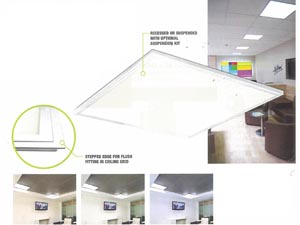
Interviewed by CENS Lighting magazine, Andrew Johnson, chief executive officer of British lighting wholesaler the Aurora Group, felt that the European sovereignty debt crisis and tepid American economy do not impact the lighting industry as hard as many other industries, and that challenging times drive people to focus on saving energy.
Aurora has been drumming up sales of LED lighting amid the downturn, also aggressively investing during this downturn in infrastructure globally and also seeing this downturn as a good opportunity to invest in marketing to build profile and gain market share, said Johnson.
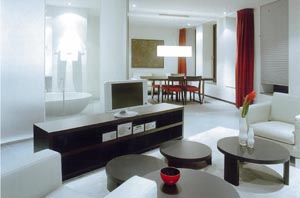
The company has developed, according to Johnson, several new products as the LED tube, LED panel, and its unique i9 fire-rated downlight.
Also this year, the company has tried to modularize lighting fixtures to help retailers. Because the cost of LED is high so the maker tries to make it easier for wholesalers to stock products. Instead of offering individual items Aurora tries to modularize them so they can have a wide range of products at lower cost, Johnson elaborated.
Modularization undoubtedly benefits buyers most. With Aurora’s modularization solution, buyers need not buy a whole bunch of lamps each capable of individual beam angle and color. Instead one product can be bought to have interchangeable bezel, lens etc., Johnson noted. For example, it offers a range of downlights with interchangeable bezels, modules and drivers.
Osram Asia Pacific
Marcel Verhoeven, marketing director of Osram Asia Pacific Ltd.’s solid state lighting business in charge of Asian market operation, said that the global lighting market has slowed modestly but Osram is still seeing tremendous sales growth in LED lighting, for LED is effective to save power spending during hard times.
Osram mostly promoted LED lighting at the Hong Kong fair this year. According to Verhoeven, although upfront cost for LED lighting is high, its energy saving usually allows users to soon recoup such investment. For example, installing LED lamps in hotels enables pay-back in six to nine months, or even shorter, he said.
Verhoeven said that LED projects now take up around 60% of Osram’s R&D budget and will increase over the next few years, although fluorescent lamps remain the company’s major revenue earners. A very good fluorescent tube can achieve 90 lumen-per-watt, which is almost achieved by LED lighting, but will likely double over the next five years.
Despite impressive efficacy improvement in LED luminosity and quick price declines of LEDs, Verhoeven conceded that LED prices remain prohibitive to most consumers, believing the acceptable price of an LED light to replace 60W incandescent bulb is below US$10 in the United States and around 10 euro in Europe. The Asian market is consumer-driven and it took a long time before consumers began adopting LEDs at acceptable prices.
The slower adoption of LED lighting by consumers than businesses is also due to, said Verhoeven, the relatively shorter duration of lighting usage daily by the former, with households being the biggest chunk of the lighting market nevertheless.
The price decline of LED lamps will be faster than for CFLs, as improvement in LED efficacy will be faster, more dramatic than for CFLs, hence enabling the faster price reduction, Verhoeven noted.
Clarifying that Osram supplies a wide range of lighting, Verhoeven said, despite its LEDs achieving outstanding 90 lumen/watt and CRI 92 on average, Osram has all kinds of lighting technologies, so the maker doesn’t have to promote only LED lighting. Fluorescent lights offer diffuse light but mediocre light quality, and LED lighting is not the best solution currently.
Regarding incandescent’s future, Verhoeven believes that demand for the energy-guzzling lamps will remain regardless of bans by major economies, due to its cheap prices in many countries. Osram will still be making incandescent bulbs in 10 years, for some specialty lighting is very difficult to do with other technologies, but its use will for sure drop.
In contrast to tepid Europe and the United States, the vibrant Asia, according to Verhoeven, will be the major growth driver of Osram’s global operation. Asia will contribute to 40% of Osram’s growth over the next years while Europe and North America will remain Osram’s biggest customer base.
Osram opened its Asian operational headquarters six years ago in Hong Kong to focus on the business in the brisk Asian market, which was handled by its Munich headquarters earlier, said Verhoeven.
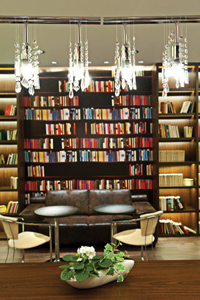
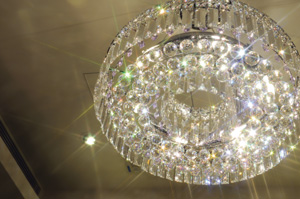
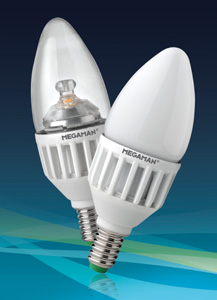
With China being not just an important market for Osram but also its biggest manufacturing base, the company has set up a product R&D center in Shenzhen, Guangdong and factories in other provinces, with another facility planned for China to specifically make LED packages for lighting, said Verhoeven.
Neonlite International
Fred Bass, managing director of Neonlite International Ltd. of Britain, operator of the energy-saving lamp brand MEGAMAN, said the global economic slowdown drives people to save energy but at different speeds from one economy to another. The incandescent bulb ban is to be completed in Europe on September 1, 2012, so energy-saving CFLs will see some significant volume for some years. The ban has motivated the company to launch LED lamps as alternative, which will start to take the premium energy-saving market in Europe, resulting in drastic change in LED penetration in the next two years.
Coping with weak demand in the euro zone, Bass said the company is expanding into developing economies for sales growth via a business initiative which the company calls “geographic expansion.” To be always in Europe, the firm is waiting for the economy to really pick up, as well as targeting the Americas which are very new markets, and will soon grow to account for up to half its sales, when Europe’s share used to be 77%.
Asia, Bass said, is Neonlite’s major non-euro market and is increasingly important to Neonlite as a source of project business. The firm is doing more sales directly in China now, but sales in Asia as a percentage of its global sales have not changed.
CFL remains the company’s major revenue earner although the company has introduced LED lamps. CFL volume will be sustained over the next years and CFL will remain a big product as incandescent is being phased out around the world, said Bass.
The company, Bass noted, will continue to refine CFL technologies, including using safe amalgam to minimize environmental impact. Neonlite’s CFLs are guaranteed to last 15,000 hours, which means a lifespan of maybe 10 years in homes that use lights for 1,000 to 2,000 hours a year, hence being a steady business driver.
The company’s strength in CFL is miniaturizing electronic controller of the lamp to develop a product of the same size as incandescent bulb, by using ICs in the controller as done with LED lamps, Bass added.
Although CFL remains Neonlite’s bread and butter, Bass estimated LED lighting sales to rise to 30%, or even higher, of revenue in the next few years from current 20%. The firm targets the premium segment by offering quality products to rise above the many poor LEDs in the market, as well as selling LEDs to consumers as alternative. In other words, the company maintains a two-channel strategy in the LED segment by continuously developing the project and consumer markets, with the focus on proving to vendors that MEGAMAN represents high quality and performance.
Like many other eco-savvy lighting manufacturers, the company has also added an iPhone application—the patented MEGAMAN LuxMeter—a free lighting measurement tool that offers tips on energy saving lamps to improve mood and environment in homes.
Nicolaudie Group
Nicolaudie Group of France is the operator of the brand “Stick” in architectural lighting. Simon Bennett, a sales rep, said the architectural lighting market as a whole has grown bigger regardless of the economic slowdown, with the firm’s sales rising again. The past quarter had been fantastic for the firm and over 100 customers, all wholesalers, visited its stand in one day.
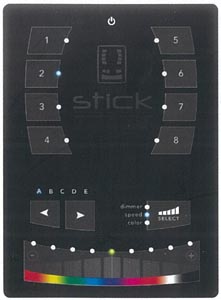
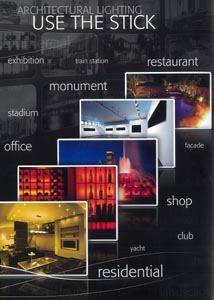
Bennett credits the company’s brisk sales mostly to innovative new lighting that is available to the architectural market. Being a lighting controller company, Stick can develop new technologies to meet increasing demand as lighting technologies improve and are innovated. Architectural lighting is not just popular in commercial market but also in residential market. Ordinary people can also have red-green-blue color changing dynamic lighting at home. So the maker aims to develop powerful and easy-to-use controllers to meet rising demand.
The company derives strength from its eagerness to invest in new software or hardware, putting it a step ahead of competitors, said Bennett. For example, the maker recently invested in building controlling interfaces around the Apple iOS and Google Android systems, allowing users to program lighting from iPods or Android phones.
The company’s first achievement in optimizing the latest technology was with the DMX digital control protocol when it introduced “one of the first computer DMX software and interfaces” 25 years ago. The maker was the very early adopter of the architectural lighting control technology, but no one had heard of DMX at lighting fairs. The maker had to sell the technology as the next step in lighting control. Now the company is kind of doing the same thing but with iPod and iPhone, said Bennett.
Among the company’s latest innovative products is its Stick-KE1 system, which is a DMX system working on PC, Mac., iOS and Android devices. In essence, users can turn on lights upon opening doors, two hours after dusk, program pink lights on St. Valentine’s Day and green on St. Patrick’s Day, said Bennett.
Intematix Corp.
Intematix Corp., a leading innovator of patented phosphor materials and components for high-quality LED lighting, sees the economic downturn as an opportunity to promote ChromaLit, a remote phosphor structure, which results in 30% higher light output than generic phosphor solutions, hence a less expensive lighting all round, stressed Alain Dangerfield, Intematix’s market communications officer.
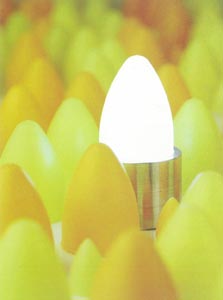
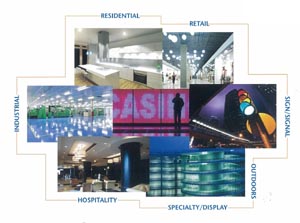
The maker’s strategy amid the economic crisis is to continue providing the phosphor and remote phosphor materials that improve the quality, brightness, and efficiency of a wide range of lighting while reducing energy consumption and operating costs for the end consumer, said Dangerfield.
According to Dangerfield, ChromaLit, an unorthodox solution compared with phosphor directly applied on blue chips, needs no diffuser, increases light extraction and lowers system operating temperature to result in 30% improved efficacy.
ChromaLit-installed lighting also achieves diffuse beam angles ranging from 215 to 280 degrees to overcome glare inherent in LED devices, with such technology suitable for residential, outdoor, industrial, retail, hospitality, specialty, and signal lighting purposes.
After launching ChromaLit in January 2011, according to Dangerfield, Intematix saw adoption take off in the U.S. because lighting manufacturers are increasingly interested in technology that improves lighting fixtures. But in Asia, awareness of remote phosphor is still quite low among lighting manufacturers. So the maker has to change the trend for there are lots of LED manufacturers in this region, having just scratched the surface of the Asian market.
Although LED technology has risen to the challenge, improving everything from TV to light bulbs, semiconductor is only part of the story. Quality LED light now depends on phosphor, which generates 95% of visible white light, said Dangerfield.
BJB GmbH & Co. KG
The century-old BJB GmbH & Co. KG, the world’s No.1 lamp-holder maker, stole the show with not lighting parts and components, but a robotic arm similar to that on automobile assembly lines. It was the premiere of this machine, dubbed automatic direct wiring system (ADS) One, in Asia although BJB had exhibited the robot over the past 15 years in every show in Germany, according to Olaf Baumeister, executive vice president of BJB Automation. It’s the right machine for less costly investment and for the maker to show it in Asia, for the lighting industry in Asia is changing towards automation for better quality and lower labor cost. Buyers may not be convinced this year but may buy next year or later, said Baumeister.
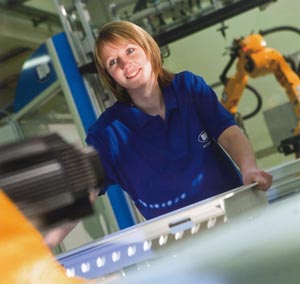
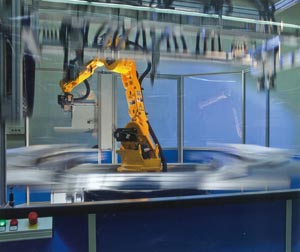
BJB branched out into automation-equipment manufacturing around 16 years ago, when one of its competitors launched an automation machine for wiring insulation-displacement connectors (IDCs) at this show. So around two or three days after the debut, some of its customers said why not build an automation machine for push-wire connectors, which BJB spent 16 months to develop, show and sell to a customer. That’s how the business started, Baumeister recalled.
BJB rolled out ADS ONE in 2010 at the Frankfurt Light+Building show. The European debt crisis also has discouraged investment in new machines for many months, affecting the company’s ADS business. The crisis has past in Germany and things are looking up because in the Frankfurt show people begin investing in automation again, said Baumeister.
ADS ONE is the smallest, lowest priced ADS that BJB has ever built. Despite the lukewarm global economy, BJB, according to Baumeister, has sold over 20 ADSs over the past 12 months, making it the top player in this field. Over 130 machines have been sold to customers making lighting fittings over the past 15 years, most of whom in West Europe. The maker has begun selling the machines in South Africa and the Americas, as well as having sold recently a machine to a Malaysian company and another to a Chinese company to start sales in Asia, said Baumeister.
ADS ONE is ideal for wiring T8, T5 and compact fluorescent lamp (CFL) lighting fittings, being an efficient tool that takes only one to two minutes to change to two-lamp fittings from four-lamp fittings, said Baumeister.
Automation business accounts for around 5% of BJB’s total revenue, but Baumeister expects such business to increase tremendously over the next few years following the company’s decision to boost lamp-holder shipments alongside those of automation-equipment, believing customers who buy automation equipment will also buy more lamp holders.

